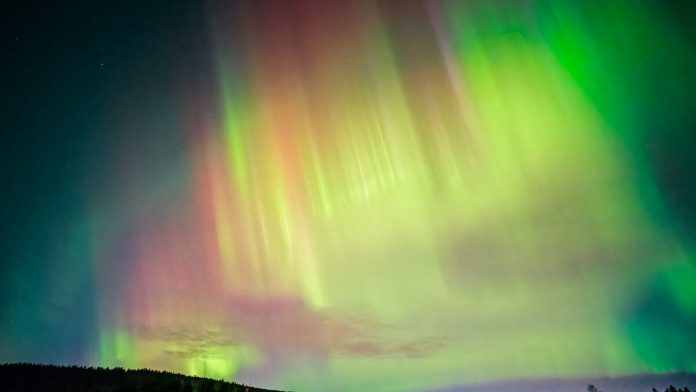A severe geomagnetic storm, ranked 4 out of 5 on the severity scale, hit Earth on Thursday (October 10), according to the National Oceanic and Atmospheric Administration’s (NOAA) Space Prediction Center. This storm, caused by a large explosion of plasma from the sun’s surface known as a coronal mass ejection (CME), could potentially create striking auroras, also known as the northern lights, across a large portion of the United States.
Auroras are generated when a surge of particles from the sun temporarily disturbs Earth’s protective magnetic field, creating a geomagnetic storm. Some solar particles trapped in our planet’s magnetic field lines are accelerated into our upper atmosphere, where they can hit nitrogen and oxygen atoms. As they excite the atoms, they release photons of light in different colors, creating the stunning display of auroras.
The storm is expected to make the northern lights visible over much of the northern half of the United States and perhaps as far south as Alabama, depending on local weather conditions and city lights. States best positioned within the aurora viewing line include the Mid-Atlantic and Midwest regions, while the Northeast and Pacific Northwest may have cloudier skies.
The CME left the sun on Tuesday evening at speeds between 2.7 million miles per hour and 2.9 million miles per hour. This is the fastest Earth-directed ejection observed since 2017. The surge of solar particles crashed into Earth’s magnetic field on Thursday morning at 11:17 a.m. ET at a speed of 1.5 million miles per hour. The Space Prediction Center said that the geomagnetic storm could last through Friday.
In addition to creating colorful auroras in the sky, the storm could also affect power systems and satellite operations, including low Earth-orbiting commercial satellites. However, the potential for disruption is being closely monitored by the NOAA, which has already contacted North American power grid operators and guarantees they are taking precautions. There are concerns that any outages could impact rescue and recovery efforts in Florida as the state deals with the aftermath of Hurricane Milton.
This is the second geomagnetic storm this week, following one that brought aurora sightings to the northern half of the United States on Sunday and Monday. The previous storm was weaker than predicted but still brought the aurora down to Maryland and other Southern states.

Recent Comments